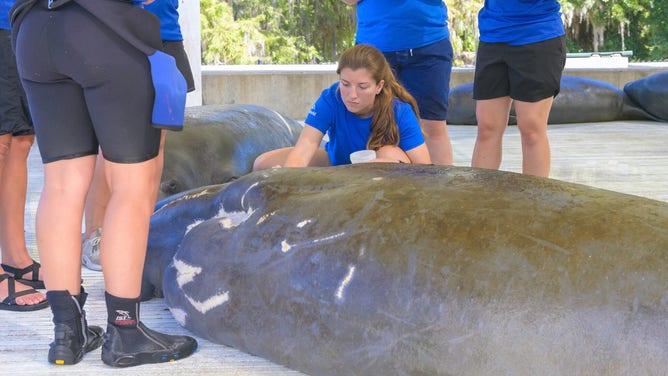Florida manatee feeding program uses up 400,000 pounds of lettuce to help save threatened species
The Florida Fish and Wildlife Conservation Commission estimates there are only around 7,500 manatees left in Sunshine State.
Florida manatees dying at an alarming rate
800 manatees died in 2022 and now there is a call for the species to be moved onto the Endangered List. Fox News multimedia reporter Caroline Elliott has the latest.
The second year of a pilot feeding program designed to reduce starvation among Florida manatees has ended with officials reporting giving out nearly 400,000 pounds of lettuce in a popular lagoon that the giant sea cows congregate in during the winter months.
The program was initiated in late 2021 after hundreds of manatees died along Florida’s east coast, setting a record for deaths.
Biologists characterized the deaths as an Unusual Mortality Event and attributed the starvation to the die-off of important seas grasses – an essential nutrient for the herbivores.
So far, in 2023, the Florida Fish and Wildlife Conservation Commission reports 215 sea cows have died, which is the lowest rate in more than two years.
"The rescue and carcass response along the coast were well below what we experienced the past two winters. This could be due to multiple factors. Late last year, we had a seagrass survey that showed some slight recovery in Mosquito Lagoon, which continues to be a high-use manatee area and in December, we worked with USGS and did some research captures in the Indian River Lagoon, and those animals looked like they were pretty decent body condition," said, Andy Garrett, an FWC marine mammal stranding coordinator.
FLORIDA’S MANATEE DEATH TOLL FALLS SHORT OF RECORD LEVELS BUT REMAINS ALARMINGLY HIGH
Additionally, the usage of the temporary feeding site in Central Florida is believed to be playing a role in the reduction of starvation, but agencies say they do not have a complete understanding of its impacts.
State and federal agencies are currently monitoring the animals as they migrate from winter habitats back to other warm water locations and will use the summer and fall to conduct assessments and determine what additional actions may be needed to aid the threatened species.
"With winter coming to an end and manatees dispersing along the coast, we anticipate normal live and dead stranding levels along the Atlantic coast. And although this risk of starvation for manatees decreases as you move into summer, we’re still going to have, but they’re still going to be faced with traditional threats like watercraft, collisions and entanglements," said Garrett.
RED TIDE TRACKER: FLORIDA BEACHES FACE RED TIDE THREAT AS TRAVELERS HEAD SOUTH IN SEARCH OF SUNSHINE
Increased impacts from red tide
Despite lower levels of red tide being observed along Florida’s Gulf Coast, the sea cow population continues to feel the impacts of the harmful algal bloom.
Experts say the microscopic algae produce toxins that can be harmful to fish, mammals and birds and can reduce oxygen levels in waterways.
According to the FWC, at least 20 cases of dead manatees along the Florida coast from St. Petersburg southward to Marco Island are suspected to be from red tide.
Additionally, several others of these giant mammals are in centers across the state in a recovery stage.
What is a red tide and why are they dangerous?
A "red tide" is a harmful algal bloom that occurs when algae in the ocean and freshwater grows out of control.
"These cases are particularly challenging because manatees must be kept in extremely shallow water when they first come in. And until that neurotoxin clears, and they become stable, and they can’t be released back to the wild until red tide clears and the area where they were rescued," said Terri Calleson, the Florida manatee recovery lead for the USFWS.
Unlike with the Unusual Mortality Event impacting manatees on Florida’s east coast, biologists say the impacts associated with the red tide event were expected, and preparations have been underway for months.
Rescue organizations across the state have added containing pools and additional resources for the influx of animals and their long recoveries.
ONLY IN FLORIDA: WATCH A MANATEE CHASE AN ALLIGATOR AT A FLORIDA PARK
Rescued manatee undergoes groundbreaking procedures
A manatee not impacted by either the red tide event along the state’s west coast or mass starvation along the state’s east coast is a mother who was nicknamed ‘Reckless.’
‘Reckless’ and her calf were rescued in May 2022 with what were described as catastrophic boat strike injuries to the mother.
SeaWorld Orlando says during the nearly year-long stay at its facility, veterinarians performed nine lifesaving procedures to repair her injuries.
Some of the unprecedented procedures included a complete pectoral flipper amputation, cold laser therapy, abscess removal and a gastroscopy.
"When we first saw her, she was in one of the worst conditions our team had ever seen. She had massive open wounds, an exposed shoulder blade, protruding bones and other serious ailments. All of us felt like her chances of survival, even with help, were very low," Dr. Stacy DiRocco, a senior veterinarian at SeaWorld Orlando, said in a statement.
Without the care from the SeaWorld team, it is widely thought among experts that neither the mother nor her calf would have survived in the wild.
The prognosis for the manatee's recovery is considered good, and the SeaWorld team plans to release both animals in the Florida waters.
With their annual migration season underway, officials warn boaters to be cautious of the endangered species, and if they see an animal in distress, let the FWC know about it by calling 888-404-3922.



